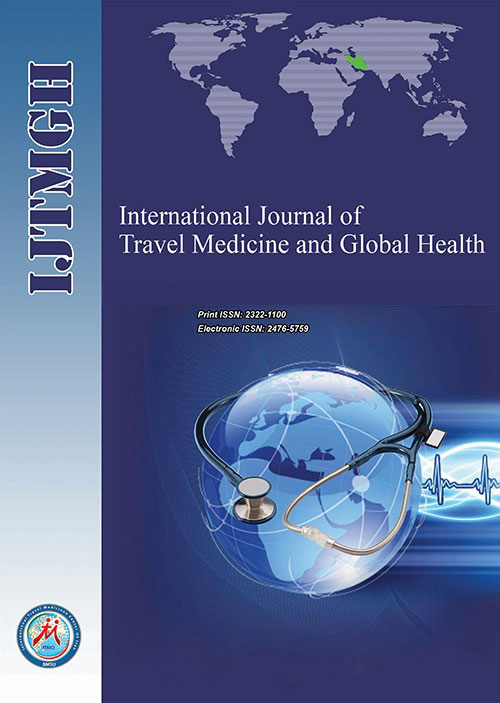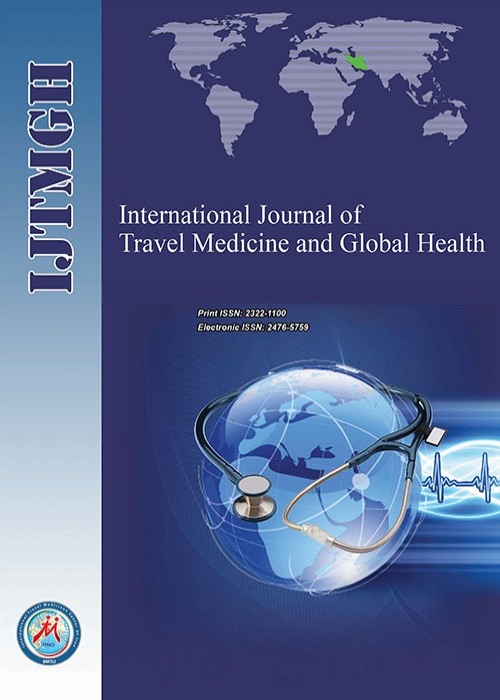فهرست مطالب

International Journal of Travel Medicine and Global Health
Volume:8 Issue: 2, Spring 2020
- تاریخ انتشار: 1399/03/22
- تعداد عناوین: 7
-
-
Pages 46-50IntroductionSocial media has become an important element of interaction and found itself a place in every aspect of our lives. This study examined the twitter activities of emergency medicine physicians and residents (EMP&R) about the COVID-19 outbreak.MethodsThe study concentrated on Twitter, a major social media network. To identify accounts owned by EMP&R, followers of the official accounts of two emergency medicine physician associations in our country were reviewed.ResultsIn total, 251 accounts whose owners stated they were EMP&R in their biographies, were public, and had tweeted within the last year were identified. Among the 210 tweets posted about coronavirus, 42.4% contained comments and suggestions, 18.6% institutional announcements, 17.1% news, 14.8% scientific content, and 7.1% contained humor.ConclusionThis study examined the importance of Twitter posts during outbreaks and the attitudes of emergency medicine doctors on this issue. Based on the results, it is thought that EMP&R should share more.Keywords: Social Media, Emergency medicine, Disease Outbreaks, Coronavirus
-
Pages 51-57Introduction
Although several coronavirus disease 19 (COVID-19) studies have focused on the biomedical and epidemiological manifestations of the COVID-19 virus, there is a dearth of studies that have reported the experiences of COVID-19 survivors. This study investigated the physiological and psychological experiences of COVID-19 survivors and the quality of care that they received during their recovery processes.
MethodsA phenomenological approach and a purposive sampling technique were employed to select eligible participants whose reported interviews/videos were published on reputable online media channels. The selection processes involved three researchers who had independently searched and assessed the interviews and their sources; for veracity, availability of vital information to meet the study objectives, and to ensure it followed the inclusion criteria. Video interviews were transcribed and data were analyzed using thematic analysis.
ResultsThirty-nine participants (COVID-19 survivors) within the age range of 20-95 from over 15 countries and 5 continents were included in this study. Clinical symptoms commonly reported included feeling feverish, severe, persistent and dry cough, difficulty in breathing, cold, body pains, and aches. Many participants had negative mental health experiences such as being scared, anxious, guilty feelings, and worrying about their recovery. Few participants had positive mental health experiences such as the feeling of encouragement from family and trusted friends. Many participants were satisfied with the quality of care at health centers, though some experienced early difficulty in getting tested.
ConclusionThere are psychological impacts associated with the SARS-CoV-2 infection. Psychological interventions should be included in the management of COVID-19 patients and survivors.
Keywords: COVID-19, Qualitative study, mental health, Physiological Experience, COVID-19 Survivors -
Pages 58-65IntroductionInternational travelers are exposed to health risks and may transmit infections before, during, or after travel. Travelers are expected to take vaccinations prior to travel. The current study assessed the factors associated with the practice of pre-travel vaccination among travelers departing through Addis Ababa Bole International Airport after their stay in Ethiopia.MethodsThis cross-sectional study was conducted among 670 international travelers. A multistage sampling technique was used to ensure the representativeness of travel destinations. Awareness and practice of pre-travel vaccination were assessed using a self-administered questionnaire distributed at the departure lounges of the airport. Logistic regression analysis was used to identify significant factors (at P < 0.05) associated with pre-travel vaccination status. Median age was reported with its interquartile range (IQR).ResultsA total of 639 questionnaires were analyzed given a response rate of 95.4%. The median age of participants was 34 years (IQR 28-41). Five hundred and eighty travelers (90.8%) were aware of pre-travel vaccinations, 531 (83.1%) took vaccinations, and 185 (29.0%) had their vaccination cards checked upon arrival in Ethiopia. The vaccination rate of the three recommended vaccines for all travelers were yellow fever (72.5%); diphtheria, pertussis, and tetanus (DPT) (21.4%); and influenza (10.8%). Age, marital status, religion, and having vaccination cards checked on previous trips were associated with vaccination status at P values of 0.047, 0.035, <0.001, and 0.002, respectively.ConclusionThe uptake of recommended vaccinations for all travelers, especially DPT and influenza was low. It is pertinent for border health staff to scale up vaccination card inspection at points of entry.Keywords: Airports, Border Health, International Travelers, Pre-travel, Vaccination, Yellow Fever
-
Pages 66-72IntroductionAlthough socioeconomic status (SES) resources influence population and individual health behaviors, socially marginalized groups gain significantly less health from their SES indicators, such as education and income, compared to the socially privileged groups. This pattern is called marginalization-related diminished returns (MDRs). However, most of the MDRs literature is derived from studies that have defined marginalization based on race and ethnicity. As a result, more research is needed on MDRs due to immigration. To extend what is known about MDRs due to immigration, the current study compared a national sample of immigrants and non-immigrants for the effects of education and income on current cigarette smoking of adults in the United States.MethodsThis is a cross-sectional study. The 2015 National Health Interview Survey (NHIS) enrolled 14,149 individuals who were either immigrants (n=1977; 14.0%) or non-immigrants (n=12,166; 86.0%). The independent variables (IV) were education and income that were treated as categorical variables. The dependent variable was current cigarette smoking. Age, gender, race, ethnicity, marital status, employment, and region were confounders. Immigration was the moderator. Logistic regression was used for data analysis.ResultsHigh education and income were associated with lower odds of current cigarette smoking. However, immigration showed significant statistical interactions with both education and income. These interactions were suggestive of smaller protective effects of high education and income on current cigarette smoking for immigrant than non-immigrant adults.ConclusionIn line with the MDRs, the effects of education and income on tobacco use is weaker for immigrant than non-immigrant adults.Keywords: Ethnic Groups, Immigration, Immigrants, Socioeconomic factors, tobacco use, smoking
-
Pages 73-79IntroductionIn the globalizing world; the concept of medical tourism comes to the fore with the increase in travel freedoms between countries, easier transportation facilities, and the increased quality of healthcare services in different countries. This study aims to examine the barriers to developing medical tourism and prioritize the factors to give an insight on where to allocate resources in the scope of a conceptual framework on medical tourism.MethodsBarriers to medical tourism in Turkey were identified based on the literature and experts’ opinions. As a result of the expert opinions, 23 factors were identified and grouped under five main categories. The analytical hierarchy process method was used to prioritize the factors. A pair-wise comparison form was prepared by the researcher and sent to experts. The data obtained from these forms was analyzed and weights were calculated.ResultsThe factors were ranked from most important to least important as follows: negative corporate image (w=0.319), quality of healthcare (w=0.198), incompatible regulations/law (w=0.177), human resources (w=0.163), and underdeveloped infrastructure (w=0.142).ConclusionIt was determined that the development of medical tourism is not sufficient, despite the great potential of Turkey in terms of technological healthcare services and attractiveness of tourism destinations. Major attempts should be made in marketing to attract medical tourists.Keywords: Health tourism, Medical Tourists, Turkey
-
Pages 80-88IntroductionAlthough many factors can affect the choice of destination in medical tourism, some factors are indispensable to medical tourists and medical tourism. The aim of this study was to analyze important factors affecting the selection of a destination by potential medical tourists.MethodsThis descriptive, cross-sectional study, conducted in Turkey, included a population of 1700 people and a sample size of 317 people selected through purposive sampling. Values were evaluated with a 95% confidence interval and 0.05 standard error. A value of P < 0.05 was considered statistically significant. The medical tourism scale and a demographic information form were used in data collection. Exploratory factor analysis (EFA), confirmatory factor analysis (CFA), and path analysis were used as statistical methods. Analyses were made using IBM SPSS-AMOS 25.0.ResultsIn this study, 56.5% of the participants were male and 43.5% were female. The factors affecting the selection of medical tourism destinations were determined to be, in order of importance, accessibility of health care service (X̄ = 4.68 ± 1.073), level of security and safety (X̄ = 4:57 ± 1.122), quality of health care service (X̄ = 4:39 ± 1.129), level of hygiene (X̄ = 4.16 ± 1.381), potential of savings-low cost (X̄ = 4.07 ± 1.447), and tourism opportunities (X̄ = 4.02 ± 1.540).ConclusionIt is thought that the current study will make a serious contribution to the field of medical tourism both in practice and in theory.Keywords: Medical tourism, Decision-making, Turkey, Medical Marketing, Treatment Abroad


